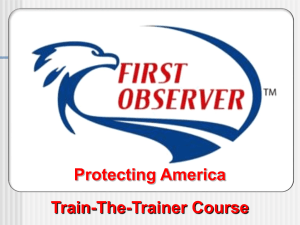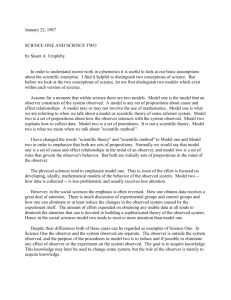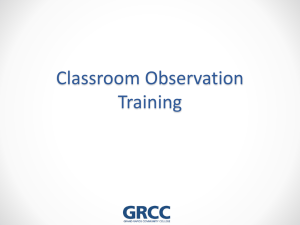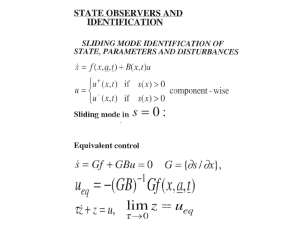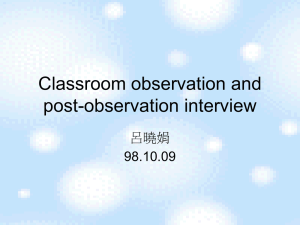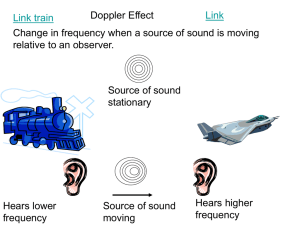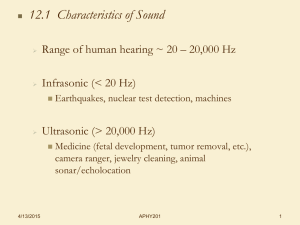Freeman
advertisement
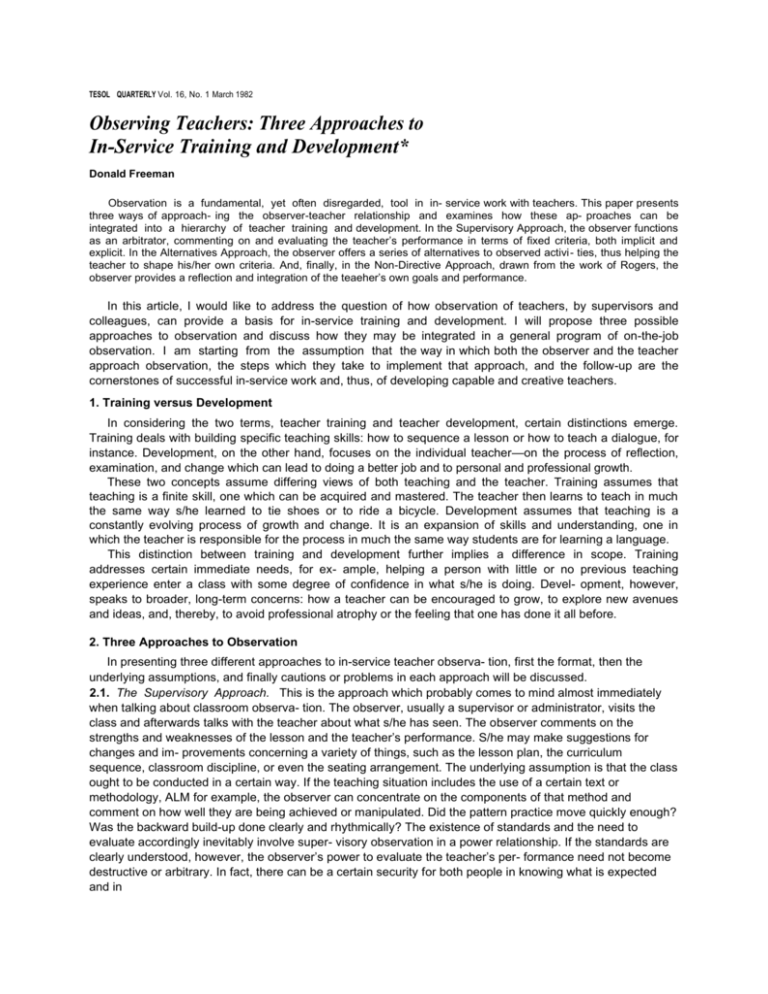
TESOL QUARTERLY Vol. 16, No. 1 March 1982 Observing Teachers: Three Approaches to In-Service Training and Development* Donald Freeman Observation is a fundamental, yet often disregarded, tool in in- service work with teachers. This paper presents three ways of approach- ing the observer-teacher relationship and examines how these ap- proaches can be integrated into a hierarchy of teacher training and development. In the Supervisory Approach, the observer functions as an arbitrator, commenting on and evaluating the teacher’s performance in terms of fixed criteria, both implicit and explicit. In the Alternatives Approach, the observer offers a series of alternatives to observed activi- ties, thus helping the teacher to shape his/her own criteria. And, finally, in the Non-Directive Approach, drawn from the work of Rogers, the observer provides a reflection and integration of the teaeher’s own goals and performance. In this article, I would like to address the question of how observation of teachers, by supervisors and colleagues, can provide a basis for in-service training and development. I will propose three possible approaches to observation and discuss how they may be integrated in a general program of on-the-job observation. I am starting from the assumption that the way in which both the observer and the teacher approach observation, the steps which they take to implement that approach, and the follow-up are the cornerstones of successful in-service work and, thus, of developing capable and creative teachers. 1. Training versus Development In considering the two terms, teacher training and teacher development, certain distinctions emerge. Training deals with building specific teaching skills: how to sequence a lesson or how to teach a dialogue, for instance. Development, on the other hand, focuses on the individual teacher—on the process of reflection, examination, and change which can lead to doing a better job and to personal and professional growth. These two concepts assume differing views of both teaching and the teacher. Training assumes that teaching is a finite skill, one which can be acquired and mastered. The teacher then learns to teach in much the same way s/he learned to tie shoes or to ride a bicycle. Development assumes that teaching is a constantly evolving process of growth and change. It is an expansion of skills and understanding, one in which the teacher is responsible for the process in much the same way students are for learning a language. This distinction between training and development further implies a difference in scope. Training addresses certain immediate needs, for ex- ample, helping a person with little or no previous teaching experience enter a class with some degree of confidence in what s/he is doing. Devel- opment, however, speaks to broader, long-term concerns: how a teacher can be encouraged to grow, to explore new avenues and ideas, and, thereby, to avoid professional atrophy or the feeling that one has done it all before. 2. Three Approaches to Observation In presenting three different approaches to in-service teacher observa- tion, first the format, then the underlying assumptions, and finally cautions or problems in each approach will be discussed. 2.1. The Supervisory Approach. This is the approach which probably comes to mind almost immediately when talking about classroom observa- tion. The observer, usually a supervisor or administrator, visits the class and afterwards talks with the teacher about what s/he has seen. The observer comments on the strengths and weaknesses of the lesson and the teacher’s performance. S/he may make suggestions for changes and im- provements concerning a variety of things, such as the lesson plan, the curriculum sequence, classroom discipline, or even the seating arrangement. The underlying assumption is that the class ought to be conducted in a certain way. If the teaching situation includes the use of a certain text or methodology, ALM for example, the observer can concentrate on the components of that method and comment on how well they are being achieved or manipulated. Did the pattern practice move quickly enough? Was the backward build-up done clearly and rhythmically? The existence of standards and the need to evaluate accordingly inevitably involve super- visory observation in a power relationship. If the standards are clearly understood, however, the observer’s power to evaluate the teacher’s per- formance need not become destructive or arbitrary. In fact, there can be a certain security for both people in knowing what is expected and in regarding performance in those terms.1 The merits of the Supervisory Approach lie, therefore, in the clarity of its standards and in its emphasis on improving specific teaching skills. However, the power relationship can be potentially damaging due to the observer’s lack of experience or to differing views toward the evalua- tive standards. In such instances, the approach can lead to friction between the observer and the teacher. If the observer seems to dwell on the short- comings of the teacher’s performance without remarking on positive aspects, the approach may lead to personal animosity rather than to improvement. 2.2. The Alternatives Approach. In this approach, the observer’s role is to suggest a variety of alternatives to what s/he has seen in class. In the process, s/he must be careful not to favor any one alternative or to sound judgmental. By presenting challenges in a nonevaluative way, the observer hopes to stimulate the teacher to think critically and, thereby, to broaden the scope of what s/he will consider doing in that classroom situation. To be effective, the observer must avoid becoming entangled in arguments about the efficacy of any one suggestion. If, for example, the teacher has asked the students to underline unknown vocabulary items in a reading passage, the observer might ask if s/he had tried having the students cross out such words instead. Alternatively, the observer could suggest having the students stop and look up each new word as they come across it. Although the alternatives should be realistic and not impossible to exe- cute under the circumstances, they need not be based on the observer’s own experience, a general philosophy of teaching, or the goals of the class per se. For this approach to work, the observer has to establish a minimally threatening middle ground so that the teacher can lower his/her defenses and be free to give the alternatives careful thought. Because the relationship between observer and teacher is one of equals, this approach avoids the power relationship found in the supervisory one. In view of past experiences with observation, however, the teacher may expect a prescriptive commentary from the observer. When con- fronted with a series of alternative suggestions, the teacher may balk ini- tially and even react with frustration. If the teacher expects to be told what to do differently and/or how to do it, the variety of alternatives will prob- ably seem confusing. In this temporary state of frustration and confusion, however, lie the seeds of critical thinking, self-evaluation, and ultimately, long-term professional development. The Alternatives Approach can thus provide a bridge from prescription, which is the basis of training, to open-ended questions, which set the groundwork for continuing professional development. The approach can focus on a particular skill (e.g., how to deal with new vocabulary), or it can deal with the issues which underlie such specifics (e.g., What is the relation between new vocabulary and what you want the students to do with the passage?). In the latter case, the discussion will center on why instead of how. The alternatives themselves will diminish in im- portance, and the weighing of pros and cons, the process of sorting out and reflecting will become primary. Thus, the transition to development has begun. 2.3. The Non-Directive Approach. The third approach is derived from Carl Rogers’ work (1951, 1961) in 2 non-directive or client-centered coun- seling. For Rogers, experience is the primary source of learning, the highest authority, the touchstone of validity” (1961:23). He argues that growth and learning are a process of discovering order, logic, and truth in one’s own experiences. Thus, progress in therapy depends, in his view, primarily on clients recognizing and understanding their own experience. When meeting a client, the counselor does not ask himself, “How can I treat or cure or change this person,” but rather, “HOW can I provide a relationship which this person may use for his own personal growth?” (1961:32). This question serves as the fulcrum for the Non-Directive Approach to observation. AS the postobservation discussion between the observer and the teacher begins, the observer must ask: What kind of relationship, what insights, can I provide which this person may use in his/her own development as a teacher? The observer’s goal is to build a relationship with the teacher which is supportive in the fullest sense. The objective is not to judge or to evaluate, but to understand in Curran’s sense (1976), and to clarify. The observer starts from the assumption that the teacher’s experiences and goals must provide the primary source of learning. As an understander, the observer, as Stevick (1980:102) puts it, “has the faith in the other’s ability-working freely within his own wholeness— to come up with what he needs.” At the outset, therefore, the observer elicits the teacher’s goals, both general and specific. In doing this the observer is careful to avoid point- blank questions like “Why did you do X?’ This would put the teacher in a position of justifying what was done and thus would establish a power relationship between teacher and observer. Instead, the observer might ask for background information: how long the teacher has been working with the class, what kinds of things they have been doing, what has worked well, and so on, always understanding whatever responses the teacher gives. After the broad parameters are set, the observer then moves the discussion to what happened in the class and the teacher’s expecta- tions, perspective, and reactions to it. Throughout this first stage in the process, the observer stays within the teacher’s world, rephrasing or using counseling responses (Curran 1976, Stevick 1980) to understand what the teacher is saying. In the reflection (the second ) stage of the process, the observer begins to relate his/her understanding of the teacher’s comments to what the s/he saw in the class, drawing on examples which support what the teacher has said. The observer does not point out discrepancies or contradictions at this juncture for the obvious reason that it would destroy confidence in the relationship and break the contract whereby the obsever has taken the teacher’s world as primary for that period of time. Having arrived at a suitable stopping point, through either a previously agreed upon time limit or a sense of the discussion, the observer then shifts the focus of the exchange to offer comments or suggestions from his/her own world of experience. Two points are critical in the observer’s transition from understanding to “standing for himself” ( Stevick 1980 ): first, the observer must make clear to the teacher what s/he is doing so that there is no confusion when s/he speaks from his/her world and, second, the observer has to maintain strict limits, realizing that s/he is offering the teacher a perspective and not advice or a prescription. At this stage, the observer can question inconsistencies in what the teacher said and what the teacher actually did in the class. To be of value, this challenging, or what Stevick (1980:106) has called “creative destruc- tion,” cannot be undertaken in an accusatory or depreciating manner. Generally, if the observer phrases the questions in the form “how to . . . ,” s/he can moderate the negative tone and thus continue a constructive exchange. In this approach, the teacher always retains the choice of acting on or ignoring the observer’s input. The teacher is in control throughout the en- tire process of observation and discussion. It can often be hard for the observer to accept that what s/he has offered may be disregarded, altered, or completely rejected by the teacher. In that sense, the roles are just the reverse of what they are in the Supervisory Approach where the observer retains total control of the process. Here, however, the observer must firmly believe with Rogers ( 1961:32) that “No approach which relies upon knowl- edge, upon training, upon the acceptance of something which is taught, is of any use in changing a person.” There can be two major pitfalls in implementing the Non-Directive Approach to observation, but both can be avoided with discipline on the part of the observer. The first pitfall lies in the temptation for the observer to coopt the process by moving it into the observer’s “world.” This slip can happen very subtly. In making a comment, the observer may say, for instance, “You said you wanted to have your students talk more. I’ve found that it’s proportional: The less I spoke, the more they talked.” If the observer stops here the process can be rescued by recentering it on the teacher’s experience. If the observer continues, however, ‘and I’ve found that clearly structured problem-solving activities were useful. Last week, we were . . .”, the process has moved from the world of the teacher to that of the observer. It is now the latter talking about his/her own experi- ences. In this case, the observer has to exercise self discipline to listen carefully to what s/he says and to monitor it for such digressions. The observer must understand and accept that his/her experience is to be drawn on as a resource but is never to overpower or dominate that of the teacher. With practice, this understanding and monitoring will follow naturally, although it will always require the discipline of self-awareness, or what has been called the “discipline of counseling” (Stevick 1980). The second danger can be a strength rather than a pitfall. There is a certain risk involved in entering into another person’s world and being truly open to it. Rogers (1961:18) writes that this risk stems from the possibility that in deeply understanding another’s perspective, the under- stander may be changed: “If I let myself really understand another per- son, I might be changed by that understanding. And we all fear change. . . . It is not an easy thing to permit oneself to understand an individual, to enter completely and thoroughly into his frame of reference. It is also a rare thing.” On perhaps a less profound level, the challenge is that of admitting the primacy of someone’s experience over one’s own. The observer has to accept that how s/he might have taught the class is irrelevant. Rather, how the class was taught and, more crucially, what the teacher was trying to do and why are the substance of the discussion. The Non-Directive Approach is a process of reflection and self-evalua- tion. Taking the teacher’s “world” as a starting point, and based on what s/he has seen, the observer helps the teacher to compare what happened in the class to his/her goals. The observer facilitates this process through the use of counseling responses, followed by comments, questions, and suggestions which reflect the teacher’s world and are not evaluative or judgmental. The approach seeks a delicate level of understanding and trust between both people. It asks the teacher to be open about what s/he wanted to happen in the class, his/her hopes and intentions, and to measure what actually took place against that standard with the help and perspective of the observer. At the same time, it asks the observer to suspend his/her own world for a limited time, to accept the primacy of the teacher’s world and so to contribute to the process of self-development. 3. The Integration of Approaches: A Hierarchy of Needs In considering the three approaches which have been presented, there seems to be an implicit hierarchy which responds to the differing needs of the teacher as s/he moves from training to development. For the beginning teacher, the paramount question is “What do I teach?” On the level of subject matter, this question can be satisfied by the use of a text- book or curricular sequence. However, as the new teacher becomes more at home with the “what,” confidence and facility increase, and the question, “How do I teach what I teach?” is more and more important. Initially, in working with the question, “what,” the trainer/observer will probably use the Supervisory Approach to observation because of its clear criteria. The” teacher’s effort and energies can thus be focused on meeting the preset objectives as best s/he can, and the trainer/observer can offer advice and suggestions towards that end. When the concept of alternative strategies to attain the same objective becomes more viable, the question arises, “How?” This may be a sign that the first stage of training is coming to a close. The question, “How do I teach what I teach?” implies alternative an- swers and thus the Alternatives Approach to observation. At this stage, the trainer/observer needs to work in a different way. The role of authority or arbitrator found in the Supervisory Approach may no longer be fruitful. Instead, the trainer/observer can become a resource, a provider of alter- native perspectives. Working in this way, the observer broadens the choices open to the teacher. As the teacher explores these alternatives, individual criteria start to develop and eventually the teacher begins to set his/her own goals. The choices raised by the Alternatives Approach lead to a third question, “Why do I teach what I teach, and why do I teach it the way I do?” The question “why” is essentially a personal one since there can be no universal answer. At this third stage, then, the trainer/developer can as- sume a supportive role in the developmental process. Through the Non- Directive Approach, the observer can help the teacher to clarify the signi- ficance of the teacher’s own experience in the light of his/her own goals. The diagram below summarizes the three approaches to observation and relates them to three stages through which a teacher must pass on the road from training to development.. Stage I II 111 Question Approach to In-Sereice Observation What do I teach? Supervisory Approach: Observer as authority/arbitrator How do I teach what I teach? Alternatives Approach: Observer as provider of alternative perspectives Why do I teach what I teach? Why do I teach the way I do? Non-Directive Approach: Observer as understander I teach? DIAGRAM 1: The Hierarchy of Needs At each stage in the teacher’s professional evolution, the in-service observer must respond to different needs. Training and development can thus be seen not as opposites but as part of a continuum. To address the question, “Why do I teach as I do?”, the questions “what” and “how” must be dealt with first. Thus if a trainer/ observer adopts the Non-Directive Ap- proach with a new teacher, one who is struggling with these first two questions, the resulting exchanges will most likely prove frustrating and counterproductive for both people. On the other hand, an experienced teacher who is told by the trainer/ observer what to do and/or how to do it, will probably chafe. The experienced teacher may react to the observer in a variety of ways, ranging from passive tolerance to outright hostility. It is valuable for the trainer/observer to understand the source of these reactions and not merely abandon in-service work with experienced faculty as is so often the case. The reactions all seem to stem from the observer’s failure, either intentionally or not, to recognize and to affirm the teacher’s experience. Thus, the Non-Directive Approach can provide a way for the observer and teacher to work together, using the latter’s world as a basis for long- term development. A Parable In one sense, the whole process of observing teachers is reminiscent of the proverb attributed to Confucius that to give a man a fish will feed him for a day, while teaching him to fish will allow him to feed himself for a lifetime. If the focus of in-service work is progressively expanded from immediate needs which can be met by training to longer term concerns, the issue of teacher development will be addressed. We will be helping teachers to feed themselves for a lifetime. REFERENCES Curran, Charles. 1972. Counseling-Learning: A whole-person model for educa- tion. Apple River, IL: Apple River Press. Curran, Charles, 1976. Counseling-Learning in second languages. Apple River, IL: Apple River Press. Stevick, Earl. 1980. Teaching languages: A way and ways. Rowley, MA: New- bury House Publishers. Rogers, Carl. 1951. Client-centered therapy. Boston: Houghton Mifflin. Rogers, Carl. 1961. On becoming a person. Boston: Houghton Mifflin. * This paper is based on a presentation first given at the Japan Association of Language Teachers’ Conference in Nagoya, Japan, 1980. The author wishes to thank Ruthanne Brown for her helpful comments on an earlier draft of this paper. Donald Freeman is on the language training staff at Procter and Gamble-Sunhome in Osaka, Japan. He has taught EFL and French and has done teacher training and cross-cultural work in the U.S. and Japan.

